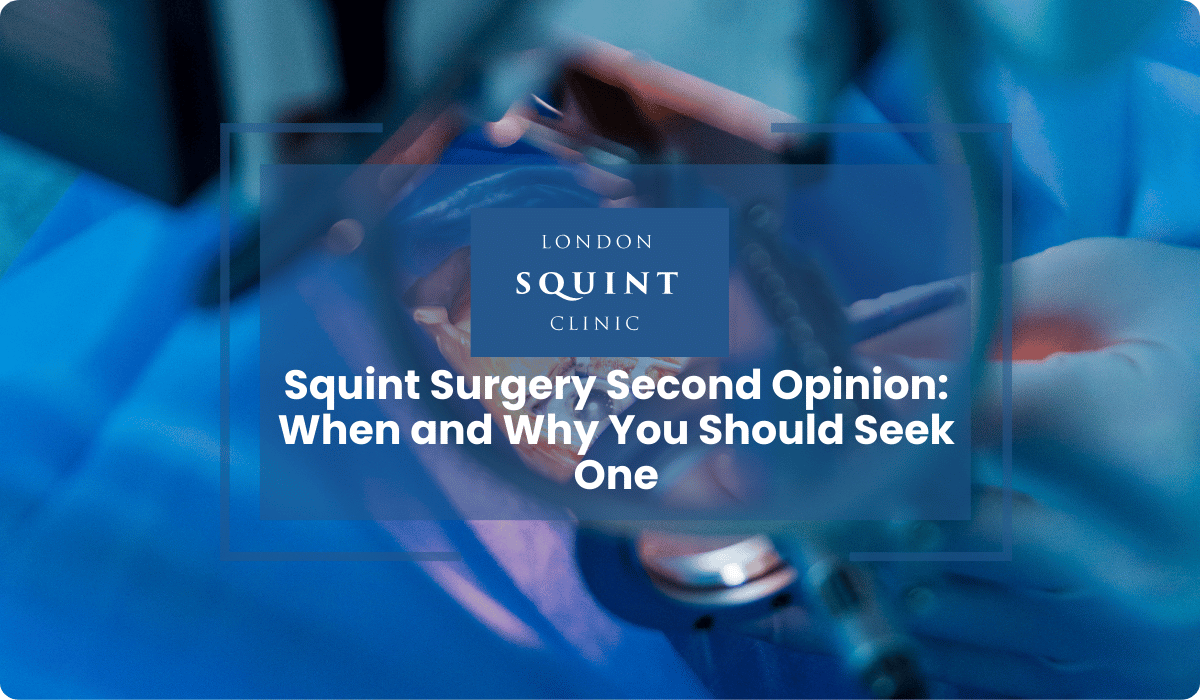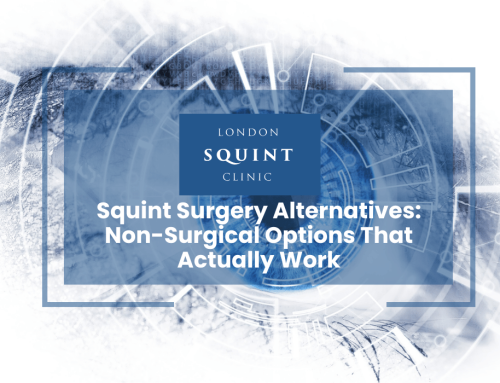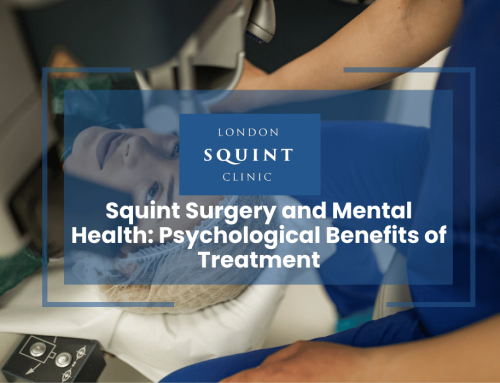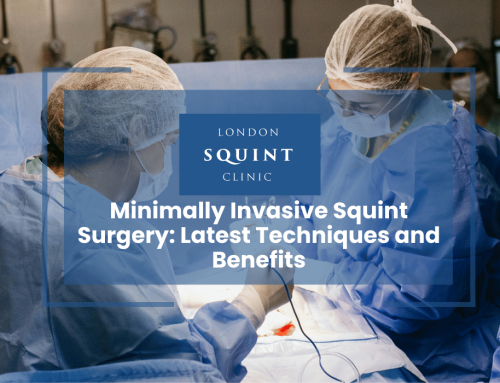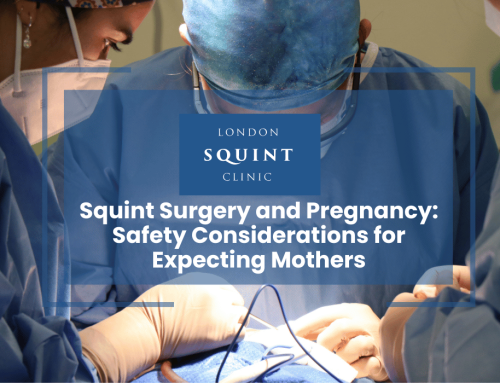Squint Surgery Second Opinion: When and Why You Should Seek One
Essential Guidance for Squint Surgery Decisions
When considering squint surgery, remember these crucial points:
- Seek a second opinion if you have a complex case, previous failed surgery, or if non-surgical options weren’t discussed
- Look for specialists with fellowship training in strabismus who regularly perform these procedures
- Bring complete medical records to your consultation, including previous surgical reports and imaging
- Consider both surgical and non-surgical approaches—prism glasses, botulinum toxin, and vision therapy may be viable alternatives
- For children, timing is critical—ask how delaying or proceeding with surgery might affect visual development
- NHS patients have the right to request second opinions through their GP or current consultant
- After gathering multiple assessments, prioritize specialists who thoroughly explain their reasoning and address your specific concerns
Remember that seeking additional expert input isn’t about questioning your doctor’s competence—it’s about ensuring you have the most appropriate treatment plan for your specific condition.
Table of Contents
- Understanding Squint Surgery and Why Second Opinions Matter
- 5 Key Signs You Should Seek a Second Opinion for Squint Treatment
- How to Find a Qualified Squint Specialist for Consultation
- What to Expect During a Second Opinion Appointment
- Comparing Treatment Options: Surgery vs. Non-Surgical Alternatives
- Should I Get a Second Opinion If My Child Needs Squint Surgery?
- Navigating Insurance and Costs for Specialist Consultations
- Making an Informed Decision After Multiple Expert Assessments
Understanding Squint Surgery and Why Second Opinions Matter
Squint surgery (strabismus surgery) is a specialised procedure designed to realign the eyes when they point in different directions. While many ophthalmologists perform this surgery, the complexity of eye muscle mechanics means that outcomes can vary significantly based on surgical expertise and approach.
Seeking a second opinion for squint treatment isn’t about questioning your doctor’s competence—it’s about ensuring you have explored all available options before proceeding with surgery. Strabismus is a complex condition with multiple potential causes and treatment approaches. What works for one patient may not be appropriate for another.
Second opinions are particularly valuable because:
- They provide confirmation or alternative perspectives on diagnosis
- They may reveal additional treatment options you weren’t aware of
- They can clarify surgical risks specific to your condition
- They ensure the proposed surgical plan is appropriate for your specific type of squint
- They may identify non-surgical alternatives worth trying first
Remember that squint surgery involves adjusting the delicate muscles that control eye movement. The difference between a good and excellent outcome often depends on surgical planning, technique, and the surgeon’s experience with your specific type of strabismus. A second specialist consultation can provide valuable peace of mind before proceeding with treatment.
5 Key Signs You Should Seek a Second Opinion for Squint Treatment
While most ophthalmologists provide excellent care, certain situations warrant seeking additional expert advice before proceeding with squint surgery. Here are five indicators that a second opinion might be beneficial:
1. Complex or Unusual Presentation
If you have an atypical form of strabismus, such as Duane syndrome, Brown syndrome, or a pattern strabismus, consider consulting with a specialist who routinely manages these conditions. These complex presentations often require modified surgical approaches that general ophthalmologists may encounter less frequently.
2. Previous Failed Surgery
If you’ve already undergone squint surgery without achieving the desired outcome, a second opinion is particularly valuable. A specialist may identify factors that contributed to the previous unsuccessful result and suggest alternative approaches. Re-operation requires careful planning and sometimes different techniques than initial procedures.
3. Conflicting Information
When you receive contradictory advice about treatment options or expected outcomes, seeking clarification from another expert can help resolve confusion. This is especially important if you feel your questions aren’t being fully addressed or if the explanations seem inconsistent.
4. Significant Surgical Risks Identified
If your surgeon has identified particular risks in your case, such as a high likelihood of double vision after surgery or concerns about achieving alignment, consulting another specialist may provide additional perspective on risk management strategies.
5. Non-Surgical Options Not Discussed
If surgery was presented as the only option without discussion of alternatives like prism glasses, vision therapy, or botulinum toxin injections, another opinion can help you understand the full spectrum of treatment possibilities. Some cases of strabismus can be managed effectively without surgery or with combined approaches.
Remember that seeking specialist advice doesn’t necessarily mean changing doctors—it’s about gathering comprehensive information to make the most informed decision about your eye health.
How to Find a Qualified Squint Specialist for Consultation
Finding the right specialist for a second opinion on squint treatment requires careful consideration. Here’s how to identify qualified experts in strabismus management:
Look for Subspecialty Training
Seek ophthalmologists who have completed fellowship training in strabismus or paediatric ophthalmology. These specialists have dedicated additional years to mastering the complexities of eye muscle surgery and alignment disorders. In the UK, look for consultants who are members of the British and Irish Paediatric Ophthalmology and Strabismus Association (BIPOSA).
Consider Experience and Volume
The frequency with which a surgeon performs squint procedures matters. Specialists who focus exclusively on strabismus typically have more experience with various presentations and surgical techniques than general ophthalmologists who perform these surgeries occasionally.
Research Specialist Centres
Major eye hospitals and university-affiliated centres often have dedicated strabismus services with experienced teams. These institutions frequently manage complex cases and may offer access to the latest treatment approaches.
Ask About Adult Strabismus Experience
If you’re an adult with squint, ensure the specialist has specific experience treating adult patients. Adult strabismus surgery differs from paediatric cases and requires particular expertise, especially if you have had previous eye surgery or other eye conditions.
Utilise Professional Networks
Your current ophthalmologist can be a valuable resource for referrals. Ask them to recommend colleagues who specialise in strabismus, particularly for your specific type of squint. Professional courtesy typically means they will direct you to appropriate specialists.
Check Patient Outcomes
Where available, review information about the specialist’s surgical outcomes and success rates. Some clinics publish their results or can provide this information upon request. Understanding their track record with cases similar to yours can be invaluable.
When scheduling your consultation, be clear that you’re seeking a second opinion. This helps ensure the specialist understands your needs and can provide a comprehensive assessment rather than simply continuing existing treatment plans.
What to Expect During a Second Opinion Appointment
A second opinion consultation for squint treatment is a comprehensive assessment that allows another specialist to evaluate your condition independently. Understanding what to expect helps you prepare effectively and gain maximum benefit from the appointment.
Before Your Appointment
Preparation is crucial for a productive consultation. Gather all relevant medical records, including:
- Previous eye examination results
- Detailed notes from prior consultations
- Surgical reports if you’ve had previous eye operations
- Imaging studies (such as MRI scans if previously performed)
- A list of all medications you’re taking
- Your complete medical history, particularly neurological conditions
During the Consultation
The specialist will typically conduct a thorough assessment that includes:
- A detailed discussion of your symptoms and their impact on daily life
- Visual acuity testing to measure your vision in each eye
- Measurement of your eye alignment in different gaze positions
- Assessment of eye movements and muscle function
- Evaluation of binocular vision and depth perception
- Examination of the health of your eyes and surrounding structures
Discussion and Recommendations
Following the examination, the specialist will discuss their findings and recommendations. They should address:
- Their diagnosis and whether it aligns with previous assessments
- Treatment options appropriate for your specific condition
- The potential benefits and risks of each approach
- Their specific surgical plan if surgery is recommended
- Expected outcomes and realistic timeframes
- Answers to your questions about alternative approaches
Be prepared to ask questions about the specialist’s experience with your specific type of squint, their typical success rates, and how they would manage potential complications. A good specialist will welcome these questions and provide clear, thorough answers that help you make an informed decision about your care.
Comparing Treatment Options: Surgery vs. Non-Surgical Alternatives
When seeking a second opinion for squint treatment, understanding the full spectrum of available options is essential. While surgery is often presented as the definitive solution, several non-surgical approaches may be appropriate depending on your specific condition.
Surgical Approaches
Squint surgery involves adjusting the eye muscles to improve alignment. Different surgical techniques include:
- Recession: Moving a muscle attachment further back to weaken its action
- Resection: Shortening a muscle to strengthen its effect
- Adjustable sutures: Allowing fine-tuning of alignment after surgery
- Transposition procedures: Repositioning muscles to compensate for paralysed muscles
Surgical benefits include potentially permanent correction and improved binocular vision. However, risks include under or overcorrection, infection, and rarely, worsened double vision.
Non-Surgical Alternatives
Several non-invasive options may be appropriate for certain types of squint:
- Prism glasses: Special lenses that bend light to compensate for misalignment, particularly useful for managing double vision
- Botulinum toxin injections: Temporary weakening of overactive eye muscles, which can be diagnostic or therapeutic
- Vision therapy: Structured visual exercises to improve eye coordination and binocular function
- Patching therapy: Primarily for children with amblyopia (lazy eye) associated with squint
- Orthoptic exercises: Specific eye movement training that may help control certain types of intermittent squint
Combination Approaches
Many specialists now recommend integrated treatment plans that combine surgical and non-surgical elements. For example:
- Pre-surgical botulinum toxin to test potential surgical outcomes
- Surgery followed by vision therapy to enhance binocular function
- Partial surgical correction complemented by prism glasses
A comprehensive second opinion should include discussion of which approaches are most appropriate for your specific type of squint, age, visual status, and lifestyle needs. The ideal treatment plan balances effectiveness, risks, recovery time, and long-term outcomes based on your individual circumstances.
Should I Get a Second Opinion If My Child Needs Squint Surgery?
When your child is diagnosed with strabismus requiring surgical intervention, seeking a second opinion is particularly valuable. Children’s visual systems are still developing, making treatment decisions especially consequential for their long-term visual function and development.
Why Paediatric Cases Warrant Additional Consideration
Children with squint face unique considerations that make second opinions particularly beneficial:
- Their visual system continues developing until approximately age 8-10
- Early intervention can prevent amblyopia (lazy eye) and promote binocular vision
- Children may not accurately report visual symptoms
- The timing of surgery can significantly impact outcomes
- Children may require different surgical approaches than adults
Key Questions for Paediatric Second Opinions
When seeking another specialist’s assessment for your child, consider asking:
- Is surgery necessary now, or could we safely monitor the condition?
- What non-surgical treatments might be tried first or alongside surgery?
- How might delaying surgery affect my child’s visual development?
- What is the likelihood of needing additional surgeries as my child grows?
- How will you manage amblyopia before and after surgery?
- What specific surgical technique do you recommend for my child’s particular type of squint?
Specialist Considerations for Children
For paediatric squint cases, look for specialists with specific expertise in:
- Paediatric ophthalmology and strabismus
- Managing complex childhood eye conditions
- Child-friendly examination techniques
- Experience with various surgical approaches for different age groups
- Comprehensive amblyopia management
Remember that children’s squint surgery often requires general anaesthesia, adding another dimension to treatment considerations. A second opinion can help ensure that surgery is truly necessary and timed appropriately for your child’s visual development, while confirming that all conservative options have been adequately explored.
Navigating Insurance and Costs for Specialist Consultations
Understanding the financial aspects of seeking a second opinion for squint treatment is an important practical consideration. While the clinical benefits are clear, managing costs effectively ensures you can access the expertise you need without unnecessary financial burden.
NHS Pathways for Second Opinions
Within the NHS, patients have the right to seek a second opinion, though the process requires some navigation:
- Discuss your desire for another specialist assessment with your current consultant or GP
- Your doctor can refer you to another NHS specialist for a second opinion
- If your request is declined, you can speak with the Patient Advice and Liaison Service (PALS) at your hospital
- Be aware that NHS second opinions may involve waiting times
Private Healthcare Options
Private consultations offer more immediate access to specialist opinions:
- Self-pay consultations typically range from £150-£300 for specialist ophthalmologists
- Private health insurance often covers second opinions, but check your policy details
- Some insurers require GP referrals even for private second opinions
- Consider asking about video consultation options, which may be more cost-effective
Maximising Value from Paid Consultations
If you’re paying privately for a second opinion, these strategies help ensure good value:
- Request a detailed written report that you can share with other healthcare providers
- Ask about the consultation fee structure in advance, including any additional costs for tests
- Prepare thoroughly by organising all previous medical records to avoid duplicate testing
Frequently Asked Questions
Is it rude to ask for a second opinion about squint surgery?
No, it’s not rude to ask for a second opinion about squint surgery. It’s a common and accepted practice in healthcare, especially for elective procedures. Most ophthalmologists understand that patients want to make informed decisions about their eye health and will respect your desire to gather additional expert perspectives. You can politely explain that you’d like to confirm the diagnosis and treatment plan before proceeding with surgery.
How do I know if my squint surgeon is experienced enough?
To determine if your squint surgeon is experienced enough, look for subspecialty training in strabismus or pediatric ophthalmology, ask about their annual volume of squint surgeries, inquire about their experience with your specific type of squint, check if they’re affiliated with specialist eye hospitals, and review their professional memberships (such as BIPOSA in the UK). Don’t hesitate to ask directly about their success rates and how they manage complications.
Can squint surgery make my vision worse?
Squint surgery rarely makes vision worse in terms of visual acuity. However, complications can occur, including temporary or persistent double vision, under or overcorrection requiring additional surgery, or rarely, infection. The risk of serious complications affecting vision is very low (less than 1%). A qualified specialist will carefully assess these risks based on your specific condition and discuss them thoroughly before proceeding with surgery.
How long is the recovery period after squint surgery?
The recovery period after squint surgery typically involves 1-2 weeks of noticeable redness and mild discomfort, with most patients returning to normal activities within 2-3 weeks. Complete healing of the eye muscles and final alignment may take 6-8 weeks. Children often recover more quickly than adults. Your surgeon should provide specific guidelines regarding return to work, school, driving, and physical activities based on your individual case.
Are there alternatives to surgery for adult squint?
Yes, there are alternatives to surgery for adult squint, including prism glasses that bend light to compensate for misalignment, botulinum toxin injections to temporarily weaken overactive muscles, vision therapy exercises to improve eye coordination, and in some cases, specialized contact lenses. The suitability of these alternatives depends on your specific type of squint, its cause, severity, and whether you experience double vision or other symptoms.
How do I decide between conflicting opinions about my squint treatment?
When facing conflicting opinions about squint treatment, first ensure you understand each specialist’s reasoning by asking specific questions about their recommendations. Compare their experience with your type of squint, consider getting a third opinion if necessary, weigh the risks and benefits of each approach, and reflect on which treatment aligns with your priorities (such as cosmetic appearance versus functional vision). Trust your instincts about which specialist communicated more clearly and thoroughly addressed your concerns.
Will my child outgrow their squint without surgery?
Some children do outgrow certain types of squint, particularly intermittent exotropia (outward turning) and accommodative esotropia (inward turning related to focusing efforts), especially with appropriate non-surgical interventions like glasses or patching. However, constant squints present from birth rarely resolve without intervention. A pediatric ophthalmologist can assess the specific type of squint and monitor its progression to determine if surgery is necessary or if the condition might improve with conservative management.
Find out if you are suitable for Double Vision Treatment
Not everyone is eligible for double vision surgery.
Find out if you could benefit from this life-changing surgery by taking the quick self-suitability quiz below:
Our most popular procedures

Hello, I’m Nadeem Ali
I’m one of the few eye surgeons in the world with 100% focus on Squint and Double Vision Surgery.
I have 24 years of eye surgery experience, and worked for 13 years as a Consultant at London’s renowned Moorfields Eye Hospital.
In 2023, I left the NHS to focus fully on treating patients from across the world at the London Squint Clinic. You can read more about me here.
There’s lots of information on the website about: squint surgery, double vision surgery and our pricing.
The most rewarding part of my job is hearing patients tell me how squint or double vision surgery has changed their lives. You can hear these stories here.
Mr Nadeem Ali
MA MB BChir MRCOphth FRCSEd(Ophth)
